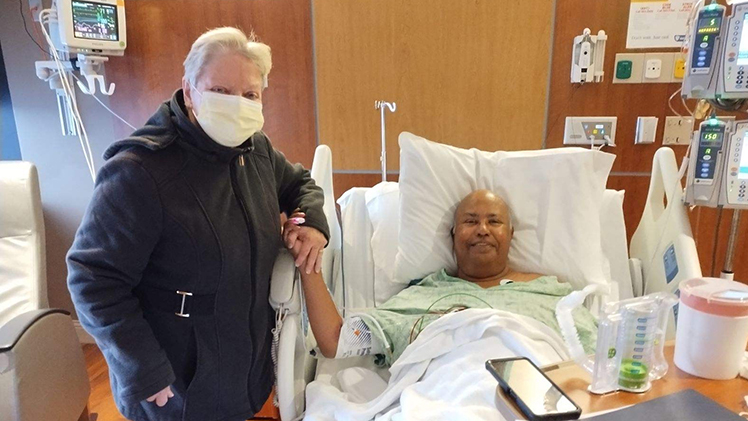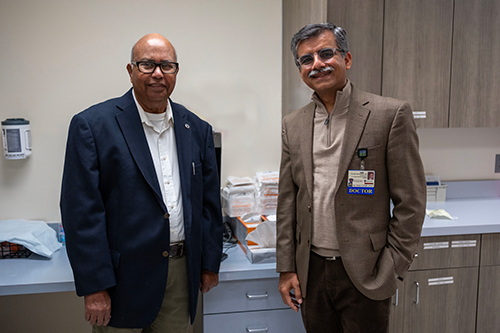Georgette Mihaljevic once tried to get over her fear of needles by volunteering to give blood. After passing out during three consecutive attempts, she was kindly asked not to try again.
But when Mihaljevic learned her close friend and former neighbor, retired scientist Dr. Rafat Ansari, needed a kidney transplant, she quickly volunteered to go through the rigorous testing to see if she might be a match.

Georgette Mihaljevic, left, donated one of her kidneys to her close friend and former neighbor, Dr. Rafat Ansari. The pair underwent successful back-to-back surgeries at UTMC at the end of November.
“My fainting would be nothing compared to what Rafat was going through,” she said. “I was going into this with my eyes wide open. I knew what the risks were, and I was willing to take them.”
Roughly two years ago, routine bloodwork had revealed that Ansari’s kidneys were not functioning as they should. Before long, the Avon, Ohio, resident was forced to begin temporary dialysis — an often-grueling process that uses artificial means to clear toxins from the blood.
As his condition worsened, his nephrologist suggested he look into getting listed for a kidney transplant.
Ansari, however, initially brushed off Mihaljevic’s offer. Not wanting to put someone else through what he saw as an burdensome surgery, he preferred to try instead for a deceased donor kidney.
Even after discovering the wait list at a hospital near his home in northeast Ohio was between three and five years — time he might not have — he was hesitant to accept.
“My basic concern was what could happen to her,” he said. “Would she be normal with one kidney? What happens to her if she gets sick?”
Eventually, with persistence from Mihaljevic and assurances from his nephrologist that kidney donation is a safe, well-established process with minimal risk, Ansari agreed.
On the recommendation of his doctor, he and Mihaljevic contacted The University of Toledo Medical Center and began their evaluation process.
Testing found Mihaljevic was a perfect match for Ansari and healthy enough to move forward. On Nov. 27, 2023, less than a week after Thanksgiving, the pair underwent successful back-to-back surgeries at UTMC.
“It was a wonderful experience. UTMC was very quick and very efficient,” Ansari said. “Everyone — the surgeons, the nurses, the hospital staff, pharmacists, my transplant coordinator, Gabby Johnson — they’re talking to you, they’re making you feel at ease and they’re very compassionate people. Compassion is very important in healthcare and I saw that at UTMC.”
The only real obstacle to the procedure was that Mihaljevic’s kidney was supplied by three arteries rather than the usual one.
Dr. Puneet Sindhwani, the surgeon who performed Ansari’s transplant, said the team knew in advance of the unusual anatomy and had planned out the challenging procedure.
“Having multiple arteries is pretty rare and makes it a higher risk transplant,” said Sindhwani, chair of the UTMC Department of Urology and Kenneth Kropp Endowed Professor of Urology at the UToledo College of Medicine and Life Sciences. “Some centers would decline taking these donors all together. It took a team effort, led by two experienced surgeons, to prepare the kidney for transplantation. But he’s doing great. We were able to sew the vessels cleanly with minimal blood loss and his recovery was eventless.”
A little more than four months after their procedures, both Mihaljevic and Ansari are doing well.

Dr. Rafat Ansari, left, poses with Dr. Puneet Sindhwani, the UTMC surgeon who performed Ansari’s kidney transplant.
Fear of needles aside, Mihaljevic has no regrets about donating her kidney. She was discharged from UTMC the day after her procedure and back to her normal routine of playing with her 7- and 11-year-old grandchildren a week later.
“People talk about donating a kidney as a sacrifice. I don’t feel like it’s a sacrifice. I’ve got a perfectly good working kidney. I’m doing well. I’m able to feel I’ve helped somebody else. I think more people could consider it,” she said. “Every time I talked to his wife, Surriya, you could hear her sadness in her voice. It’s just so much of a difference and wonderful to talk to them and hear there is such life in both of them now.”
Ansari and Mihaljevic are both scheduled to speak at an April 28 banquet celebrating living donor transplantation at UTMC as part of the University’s recognition of National Donate Life Month.
Despite his initial reluctance to accept her life-saving offer, Ansari said he’ll forever be grateful for Mihaljevic’s selfless offer.
“Inherently, she is a very kind and generous person,” he said. “She’s a wonderful human being.”
He is also grateful for the care he received from Sindhwani, whom he found himself immediately drawn to.
“He has such an amazing quality in him. He’s so detail oriented, polite and down to earth. The first time he saw me, he went through the whole thing, told me the pros and cons for this procedure,” Ansari said. “He’s a very patient man. He spent initially more than an hour with me and my wife and every time I spoke with him, he would be drawing to help explain what he was telling me.”
Sindhwani said he regularly incorporates drawings to help explain the highly technical nature of surgery, finding it helps patients better understand the procedure than words alone.
“I consider my job to involve the patient with all the knowledge that I have collected and share it with them. It’s their body, and it’s ultimately their decision and their right to know what’s going to be done and what can be expected,” he said. “I want them to feel empowered and there are studies that have shown when there’s shared decision making involved, the patient’s satisfaction is higher and the outcomes are better.”
Ansari said he had a great supporting network that included his wife of 50 years, Surryia Ansari; his daughter, neurologist Dr. Rahila Ansari, and former colleagues, neighbors and friends.
A retired NASA scientist whose body of research included development of noninvasive, novel low-power, laser-based technologies in the detection of various ocular and bodily diseases, Ansari said he once asked a flight surgeon friend what made for a good doctor.
His friend told him any doctor can treat an illness, but a good doctor treats the person.
“In this case, I would say the same about Dr. Sindhwani,” Ansari said. “He really treated me.”
Individuals thinking of becoming a living kidney donor can contact UTMC’s living donor program calling 419-383-3419.